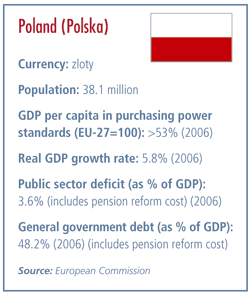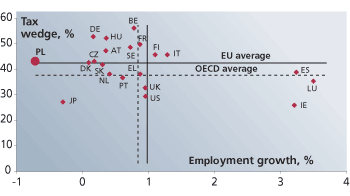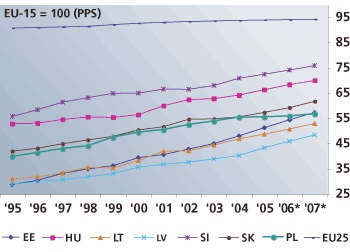Member State profile
The economy of Poland
 Poland: Renovating fast |
Transitional shocks
Unlike most of its neighbours, Poland’s transition from a centrally planned economy to a market economy began with a big bang. Following the collapse of communism in 1989, the government adopted the Balcerowicz Plan, named after the finance and deputy prime minister at the time, to combat hyperinflation and bring macroeconomic stability. Often dubbed ‘shock therapy’, the plan called among other things for allowing foreign companies to invest in Poland, lifting most price controls, freeing exchange rate transactions, and abolishing preferential treatment for state-owned firms. While some experts note that modern Poland would be much poorer without these reforms, the plan was highly controversial and socially costly. |
Under communism, Poland was an important center for steel, coal and shipbuilding amid an abundance of raw materials and of skilled and unskilled labour. Today, Poland enjoys a strong competitive position in other capital-intensive and low- to medium-skilled industries, in contrast to some of its neighbours which have branched out into technology-driven industries. The economy has gained a relative advantage in pulp and paper, metal products, rubber and plastics, and printing and publishing. On the other hand, similar to its peers, Poland has seen its comparative advantage in labour-intensive industries drop sharply since the mid-1990s, especially in basic metals and clothing.
Catching up
Over the past decade, real GDP growth has exceeded 4%, above the average of the new Member States (3.8%) and significantly above the EU-15 average (2.2%). The Polish central bank has projected 5.7% growth this year and about 5% annually in coming years. Poland has experienced a sustained, albeit periodically interrupted, long-term disinflation trend since the late 1990s. Inflation was below 1.5% at the end of 2006.
While Poland has made progress in closing the income gap and its GDP per capita relative to the EU-25 average, the difference with EU income levels remains wide. Despite noticeable improvement recently, at 15% Poland still had the highest unemployment rate in the EU and the lowest employment rate (about 51%) in 2006. The labour market has suffered in part from a large emigration of educated, highly skilled workers to other EU Member States. Foreign direct investment, while still low compared to elsewhere in the region, has played a significant role in supporting Poland’s labour-intensive and medium-technology sectors, and in giving it a new advantage in motor vehicles and electrical machinery.
Chart 1: Labour productivity – GDP per person employed relative to the EU-15
|
| * forecast |
Public finances
Poland has been running up high fiscal deficits in the last ten years: on average, the general government deficit reached 3.5% of GDP in 1996-2005. This figure does not include the cost of the pension reform introduced in 1999, which in the short term has a deficit-increasing effect (estimated at ca. 2% of GDP in 2006), but in the long term is beneficial to the sustainability of public finances. Thanks to the pension reform, Poland is among the Member States with the lowest budgetary impact of ageing. This justifies why a part of the pension reform costs can be taken into account when considering the excessive deficit procedure.
Loose fiscal policy required higher-than-desirable real interest rates in order to rein in inflationary pressures with adverse effects on private-sector investment and growth. Additional reform efforts are needed to enhance the contribution of public finances to economic growth and employment. The nominal deficit anchor of PLN 30 billion introduced in 2006 is a step in the right direction, but it is limited to the state budget and not very ambitious.
Influenced by the political election cycle, general government deficits have been expenditure-led, tailoring tax revenues to planned spending levels. The structure of public expenditure and taxes hampers growth and job creation. Spending on social protection in Poland accounts for a disproportionately high share of total government expenditure compared to the other Central European Member States (about 17% of GDP compared to 12% of GDP). It may weigh on the incentives to work and limits the scope for increasing public investment in infrastructure while crowding out private investment.
The task-oriented budgeting, planned for 2009, whereby funds are allocated to the most needed projects, is a promising initiative which could make the composition of expenditure more efficient. However, many other reforms are needed to tackle the problems of too-generous indexation rules, poorly targeted disability benefits, the heavily subsidised special farmers’ pension and disability system (KRUS), lobby-specific early retirement schemes and a high level of state aid relative to GDP.
Chart 2: A high tax wedge hampering employment growth in Poland  |
| Note: averages for 2000-2005 |
Poland spends 17% of GDP on social protection, compared to 12% of GDP for other Central European Member States. This may discourage work and limits the scope for increasing public investment in infrastructure while crowding out public investment. Poland also has a relatively high tax wedge, defined as taxes plus social contributions paid by employers and employees, as a percentage of total labour costs. According to OECD (2005) data, the tax wedge in Poland (43.1%) exceeded the OECD average (36.5%), the EU (41.4%) and the average in the new Member States (42.7%).
Preparing for the future
Poland faces an important macroeconomic challenge to reduce the general government deficit and reorient the composition of public spending to foster economic growth and employment. Towards this end, in its assessment of Poland’s progress towards the ‘Lisbon’ objectives the Commission has recommended spending restraint and additional reform efforts. More concretely, an expenditure rule could supplement the national rules on public debt; and a reform of the tax system to improve incentives to work.
“Achieving sustainable convergence will require determined policy efforts over the coming years to increase the economy’s growth potential, to which better use of the currently unemployed or inactive labour resources should make an important contribution,” said Filip Keereman, head of the unit responsible for monitoring and analysing Polish economic and budgetary developments. “This will require action to modernise the economy and to complete the public finance reform.”


